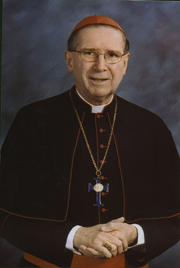Cardinal Mahony and a new imagination of human dignity

Cardinal Roger Mahony, archbishop emeritus of Los Angeles, is urgently concerned with the reform of the nation’s immigration policy, and he wants Catholic college and university students to be as concerned as he is.
Speaking with nearly 100 students and faculty members in the auditorium of Notre Dame’s Eck Hall of Law last week, Cardinal Mahony insisted that America’s 220 Catholic colleges and universities and the 800,000 students enrolled in them have a crucial role to play in immigration reform.
“Catholic universities like Notre Dame are able to bring to the discussion something that secular institutions simply can’t,” Cardinal Mahony said. “Our interest in this issue has a faith foundation which reaches all the way back to the Old Testament and to the specific laws given by God to Moses. It reaches back to Matthew 25:35, where Jesus tells us that when we welcome a stranger in his name, we welcome Him. The history of our advocacy on behalf of the immigrant is underpinned by God’s revelation and by the consistent teaching of the Church.”
Cardinal Mahony is visiting Notre Dame for a month during which he will elaborate on this theme in discussions with students and faculty, in homilies in residence hall Masses, and as a guest lecturer in undergraduate and graduate courses.
His law school talk, sponsored by Notre Dame’s Center for Social Concerns, Institute for Latino Studies (ILS), and Program on Law and Human Development, was preceded by a presentation given by Jessica Brock, postdoctoral research fellow at the ILS, on the DREAM Act. The acronym stands for Development, Relief and Education for Alien Minors, and it labels a legislative proposal brought before Congress numerous times over the past 10 years and now awaiting House and Senate committee consideration later this year.
The DREAM Act would allow children of undocumented immigrants who arrived in the United States as minors and have lived in the country continuously for at least five years to enter colleges and universities, be graduated, and become legal residents of the United States.
Cardinal Mahony and many other Catholic bishops in the United States and Mexico have been outspoken supporters of the act, which Archbishop Jose Gomez, Cardinal Mahony’s successor, has called simply “a common-sense humanitarian measure.”
“Notre Dame and other Catholic institutions of higher education have an obligation to take the lead not only in supporting such measures as the DREAM Act, but also in promoting justice and denouncing injustice toward migrants in general, and to infuse such efforts with ‘a spirit of hospitality and communion,’” Cardinal Mahony told the students, adding that “until we can energize Congress and the White House on this issue, it’s simply not going to get done. In the meantime, we want to inform you, make you aware of these issues, and involve you in the future.”
One of the organizers of Cardinal Mahony’s Notre Dame visit, Notre Dame theologian Rev. Daniel Groody, C.S.C., director of the Center for Latino Spirituality and Culture, shares this sense of the issues urgency.
“With more than 200 million migrating around the world, and over 1 billion if we include internally displaced people,” Father Groody said, “some have referred to our own times as ‘the age of migration.’ It is arguably the defining issue of our times, and what is at stake are profound human issues that are at the core of our Catholic tradition. Joining together the tradition of the Church with the tradition of Notre Dame, we hope to not only give people more information about migration but a new imagination, one that we hope will take us one step forward in creating a more just and peaceful society built on the dignity of every human being, especially those in our midst who are most vulnerable.”
Drawing on “God’s revelation and the consistent teaching of the Church” to give birth to a new imagination is a fairly tall order. But for an hour or so on an autumn afternoon in a crowded campus lecture hall, a retired churchman and some 100 Notre Dame students and faculty were already beginning to fill it.
Originally published by at newsinfo.nd.edu on October 11, 2011.